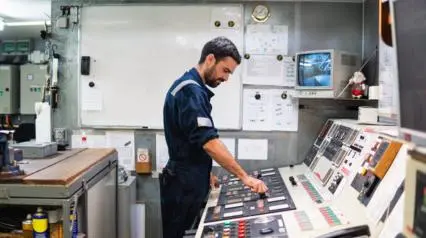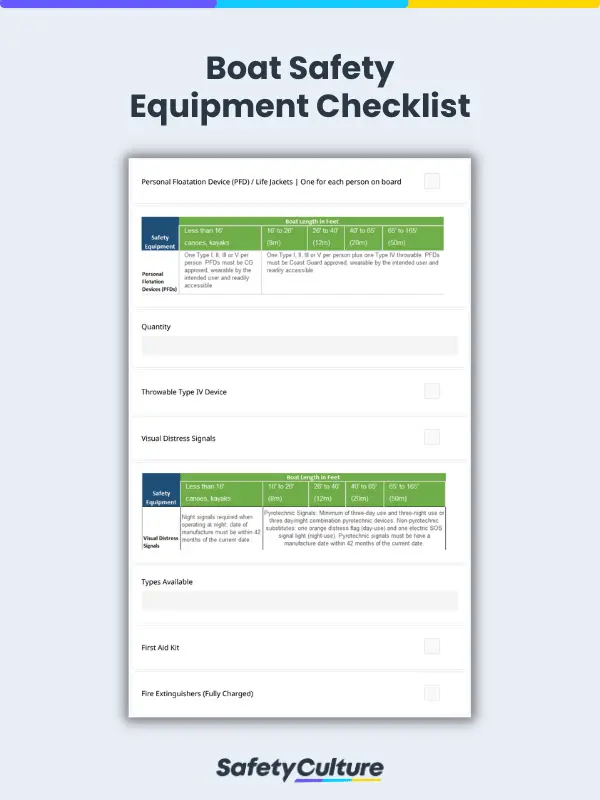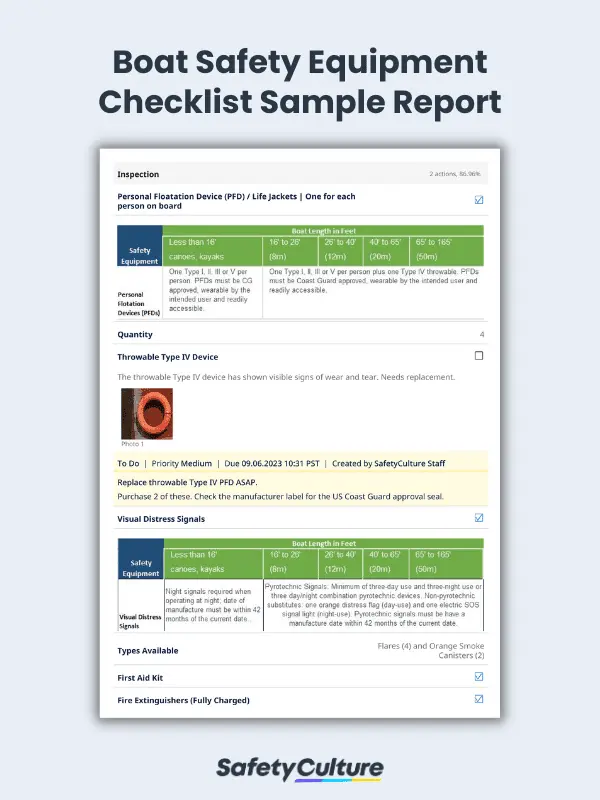What is a Boat Safety Equipment Checklist?
A boat safety equipment checklist enumerates all the essential gear and items on board to keep passengers safe and comply with safety regulations. It lets boat owners and operators prepare adequately for emergencies that may arise while on the water. With a complete equipment inventory, they can reduce risks and create a safe and pleasant boating experience.
Benefits
Using a boat safety equipment checklist gives advantages to boat owners and operators. For one, it’s a key component of emergency preparedness during sea travel. By diligently checking the vessel’s safety supplies and gear, boaters can efficiently respond to unforeseen situations with the tools they have. This preparedness is particularly crucial in potentially life-threatening scenarios.
In addition, this checklist makes it easier to abide by boat safety regulations. Boaters can tailor the requirements listed in this document based on their area of operations and create a concise guide during equipment checks. With a reliable checklist on hand, following through and being more consistent in safety equipment inspections become quick and hassle-free. It also lessens the chance of forgetting or overlooking crucial boat safety gear before setting sail.
7 Boat Safety Equipment Must-Haves
Before building your checklist, it’s important to first determine the items to include on board. Here‘s a list of the necessary safety equipment that every boat should have:
1. Personal Flotation Devices (PFDs)
Also known as life jackets or life vests, PFDs are designed to keep individuals afloat on water. Be sure to have enough vests in good and serviceable condition for each passenger on board. Boats spanning at least 16 inches must also include at least one (1) throwable Type IV device. Store them in visible areas that individuals can quickly locate and grab when needed.
Lastly, always check the label to see if these floatation devices are approved by marine safety regulatory bodies, such as the US Coast Guard and the European Maritime Safety Agency (EMSA).
2. Distress Signals
Distress signals are used to communicate for help in case of an emergency. Boaters can alert nearby vessels or authorities using any of the following tools:
- Pyrotechnic flares – red flares, orange smoke signals
- Distress flags – orange distress flag during daytime
- Electric SOS signal lights – for night use only
- Emergency radio beacons
- Other night signals
3. Firefighting Equipment
Boats run the risk of fire hazards, ranging from fuel leaks to tank explosions. For this reason, it’s crucial to have firefighting equipment readily available on board. Examples include fire blankets, fire extinguishers, and onboard fire suppression systems.
Make sure to select marine-type firefighting equipment that’s appropriate for the size and type of boat being operated.
4. Ventilation
Proper ventilation is vital for keeping hazardous fumes from building up, especially in boats with enclosed spaces or engine compartments. In fact, the US Coast Guard requires this for vessels that utilize gasoline for electrical, mechanical, and propulsion power. A combination of natural and powered ventilation systems is ideal to let the air circulate in their compartments.
5. Backfire Flame Control
A backfire flame control is installed in the gasoline engine to prevent the ignition of fuel vapors, which can result in fires or explosions. This equipment typically consists of flame arrestors and flame control mechanisms, such as induction systems and velocity stacks.
6. Navigation Lights
Navigation lights are crucial for safe boating, as it allows boats to maneuver safely during the night or in low visibility conditions (e.g., rain, fog, haze). Moreover, they help other vessels find your boat’s position, size, and direction.
These lights come in 3 main types: sidelights, masthead, and stern lights. The type used will depend on the size of the vessel and the situation that calls for its use. But regardless of the lighting equipment you’re using, make sure that they function correctly and comply with the regulations in your boating area.
7. Sound-signaling Devices
Aside from navigational lights, sound-producing devices are also used to alert and communicate with other vessels. They are particularly crucial in areas with limited visibility or situations that require immediate attention.
Small boats spanning 12 meters or less need a horn or a whistle to signal their position. On the other hand, larger vessels up to 50 meters in length must have at least one bell and one horn or whistle in place.
Additional Boat Safety Tools
In addition to the ones listed above, it’s recommended to have the following safety gear and tools at your disposal during boating trips:
- First aid kit
- VHF-FM marine radio
- Magnetic compass
- Marine sanitation device
- Navigation rules
- Fenders and boat hook
- Mooring lines and heaving line
- Spare parts (e.g., fuses, spark plugs, belts, etc.)
- Extra clothing or foul weather gear
- Spare battery (fully charged)
- Sunscreen (SPF 30+)
- Flashlight and batteries
- Cellular phone
- Portable phone charger
- Binoculars
How to Use This Checklist
Using a boat safety equipment checklist is a great way to ensure all necessary safety items are on board before heading out to the water. Here’s a step-by-step guide on inspecting your safety equipment with this checklist:
- Prepare a checklist that includes all necessary boat safety equipment on board.
- Scan through the items in the checklist and understand their purpose and function.
- Go through each item on the list and gather the corresponding safety tool.
- Thoroughly check the equipment for signs of wear, damage, or expiration.
- If you spot any faulty equipment, make sure to have it replaced or repaired immediately.
- Organize the safety tools in a way that is easily visible and accessible for passengers.
- Periodically review and update your boat safety equipment checklist based on the most up-to-date safety and boating standards.
- Conduct safety briefings and drills with boat operators and passengers to ensure they‘re informed of the location and usage of all safety equipment in the vessel.
Boat Safety Equipment FAQs
A boat safety equipment checklist is a valuable tool for boat owners, operators, and authorities responsible for the safety of boaters and passengers. It covers requirements applicable to both private boat owners and commercial operators (e.g., fishing charters, tour boats, water taxis.)
Regular safety equipment checks are a must to ensure that the safety gear works as intended, especially during emergencies. Generally, they should be inspected and tested at the beginning of each boating session or before any extended trips. However, this can still change depending on factors such as the boat type, local regulations, and intended use.
Yes, several countries all over the world have different regulations regarding boat safety and corresponding equipment. Here are some of the most prominent maritime safety laws that you can check:
- United States – Federal Requirements for Recreational Boats
- United Kingdom – MGN 599 (M) Pleasure Vessels – Regulations and Exemptions
- European Union – Marine Equipment Directive 2014/90/EU
- Global – International Convention for the Safety of Life at Sea (SOLAS), 1974




